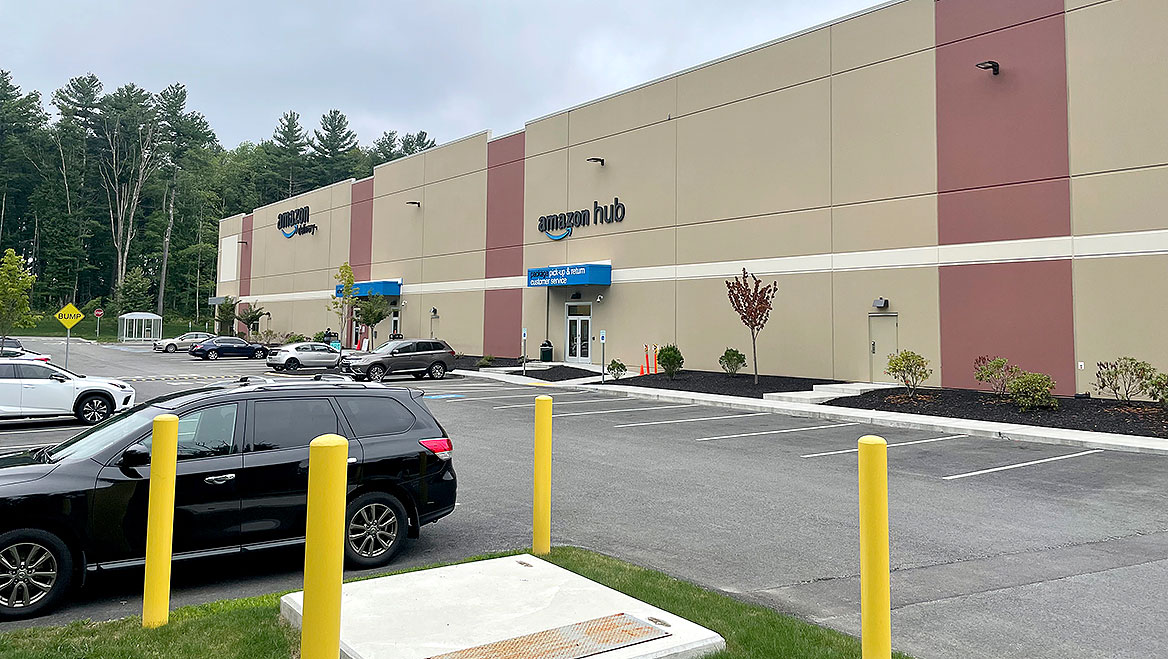Part of the Disruptors Series
Nov. 18, 2021
Bellingham, Massachusetts, a suburb about 30 miles from Boston, has become a warehouse hub. Dunkin' Brands, Best Buy, Snyder's Snacks, and others operate out of large industrial buildings, with delivery trucks coming and going regularly.
But a new warehouse facility in a wooded corner of the town is different. Its trucks aren't headed to retail stores. Instead, waves of blue vans with those ubiquitous Amazon smiles are loaded with packages to be delivered directly to doorsteps. The facility is a "last-mile" e-commerce delivery center, with traffic patterns very different from the other warehouses nearby.
E-commerce is a $750 billion industry in the U. S., comprising 13.6 percent of total retail sales. Ten years ago, that number was around four percent. The dramatic increase in online buying and selling doesn't just impact the brick-and-mortar stores. It's also fueling an unprecedented transformation of the industrial warehouse marketplace and having major effects on land use, transportation, air quality, and equity.
Consumers expect to receive the goods they purchase within a few days (or hours), and retailers like Amazon, Walmart, and Target are competing to tighten fulfillment times even more. Pressure to maintain dependable, rapid delivery has resulted in networks of last-mile delivery centers close to suburban and urban neighborhoods. Amazon, which controls approximately 40 percent of the e-commerce marketplace, is leading the push to build these facilities, which have become integral to the delivery process.

As e-commerce explodes, the traditional delivery model — factory, distributor, retail store, buyer — is being upended. The new online model requires more complex supply chain logistics, including multiple levels of inventory management and a variety of modes for the picking, packing, and shipping of online orders. From Hidden and in Plain Sight: Impacts of E-Commerce in Massachusetts.
The colossal and rapid expansion of the e-commerce industry shows no signs of slowing. That means regional delivery networks also will proliferate, so planners need to consider the impacts of last-mile delivery centers.
To help think through these issues, the Metropolitan Area Planning Council (MAPC), greater Boston's regional planning agency, talked to Boston-area planners from nine municipalities and, in February 2021, released Hidden and in Plain Sight: Impacts of E-Commerce in Massachusetts. The report zeroes in on the impacts of e-commerce in our state, but the lessons and recommendations are applicable wherever planners and municipal officials are noticing new traffic patterns from delivery trucks, facing new demand for warehouse space, or trying to referee the fight for curb space.
Breaking the mold
Before 2014, there were no Amazon warehouses in Massachusetts. Now, there are 34 active and future facilities. In the 12 months it took to research and write Hidden and in Plain Sight, Amazon's footprint in Massachusetts doubled from 10 operational facilities to 20. And the approach varies by municipality. In Dedham, Amazon leases space in an existing warehouse (and wants to expand). A warehouse built on speculation in Bellingham sat empty for several years until Amazon arrived. Worcester's vacant mall is slated to become a delivery center, and in Revere, an abandoned candy factory and multiplex cinema were repurposed as last-mile delivery centers.
Last-mile delivery centers are noticeably different from traditional warehouses, with facilities operating 24 hours a day, seven days a week. A typical "day" begins in the middle of the night, as tractor-trailers bring packages in bulk from fulfillment centers. Orders are sorted, prepped, and loaded into delivery vans. Each morning, employees drive to the facilities, park, and load themselves into the readied delivery vans. With their routes to customers' homes planned, they usually enter and leave the warehouse outside of peak traffic hours, with delivery departure times often scheduled in waves. If demand is especially high, some companies also contract with third-party delivery-service partners or use on-call drivers who make deliveries using their personal vehicles. In a typical facility, tractor-trailers, delivery vans, and on-call drivers can generate an enormous amount of activity.

A Bellingham, Massachusetts warehouse sat empty for several years before Amazon arrived. Photo by Allison Burson, Solomon Foundation.
Complicating matters, e-commerce facilities are locating near residential areas to shrink delivery times. That can add another level of noise and traffic conflicts. That is the case in Dedham (pop. 25,000). Amazon came to town in 2015, and the company recently requested to expand from its 90,000-square-foot facility to the entire 230,000-square-foot industrial site.
"The planning board, back in 2015, didn't quite grasp all the explosive growth that was going to come," notes Dedham's planning director, Jeremy Rosenberger. "This was a use unlike we've ever seen." The planning board is currently working on these issues with Amazon and is expected to propose recommendations by year's end.
Economic benefits
As with any proposed business, the costs of e-commerce facilities, such as traffic, must be weighed against economic benefits. Delivery centers can generate significant property tax revenue, and in Massachusetts, some warehouses are revitalizing previously unused properties. "We had two industrial parks that were heading south and Amazon has revived both of them," says Bob O'Brien, director of economic development for Revere. "We think both of those sites would have been vacant without them."
There are other economic wins. All the planners we talked to require Amazon delivery vans to be registered locally to ensure collection of vehicle excise taxes. Facilities also provide local jobs — an important consideration as the U.S. recovers from the COVID-19 pandemic — although transportation and warehousing jobs typically pay lower wages than other industrial uses like wholesale trade, manufacturing, and construction. Indeed, employee issues like low wages and worker treatment have arisen.
Some e-commerce companies do invest in communities where they have a large footprint. This spring, Amazon announced a $300 million commitment in the form of below-market loans and grants to create 3,000 new affordable homes near public transit in Washington State's Puget Sound area; Arlington, Virginia; and Nashville, Tennessee — all locations where Amazon has or expects to have at least 5,000 employees. Altogether, Amazon plans to preserve or build more than 20,000 affordable housing units in the U.S. through its Housing Equity Fund.
Planning considerations
So, what do planners need to be thinking about to manage the proliferation of e-commerce delivery centers in their communities already, as well as thoughtfully plan for the future?
The first is the effect on other industries and economic development. Many delivery centers are located in areas zoned for manufacturing or industrial use, resulting in a high demand for that type of real estate. According to Cushman & Wakefield, the demand for industrial space in North America in 2019 exceeded supply for the first time since before the Great Recession. As the private sector works to meet this demand, planners must evaluate if the rapid expansion of e-commerce will overtake other industrial uses that may offer higher paying jobs, and decide whether to rezone areas to direct or prevent the development of e-commerce facilities.
Trip generation is very different. The novelty of the last-mile operations model means traditional trip generation forecasting methods do not apply. The ITE's Trip Generation Manual, the go-to guide for estimating traffic patterns, does not include a land-use type that directly applies to last-mile delivery centers. Instead, planners should look for recent traffic data from similar e-commerce facilities as part of site-plan review and conduct traffic counts once facilities are operational to determine actual traffic patterns.

Demand for brick-and-mortar retail space is decreasing, meaning smaller multiplier effects from retail sales in local economies. Illustration by Jason Schneider.
Air quality can suffer. Adding more vehicles (and the vehicle miles traveled by each) means more emissions. Planners should think about how to mitigate the air quality impacts from that influx, and especially consider whether already vulnerable groups suffer disproportionally from those impacts, as some scholars suggest. Although Amazon has pledged to achieve net-zero carbon emissions by 2040, it also reported that its emissions rose 19 percent in 2020.
California's South Coast Air Quality Management District has already taken steps to lower greenhouse gas emissions and improve air quality. Last spring, it approved the Warehouse Indirect Source Rule, which targets emissions from the trucks that service warehouses, not the warehouses themselves. The rule relies on a points-based system in which warehouse operators choose from a menu of mitigation options, like using trucks fueled by electricity or natural gas, installing charging stations or rooftop solar panels, putting air filters in nearby schools and child-care centers, or paying a mitigation fee.
What's next?
The explosion of e-commerce facilities is projected to continue. According to a recent report from CBRE Group, e-commerce will account for 26 percent of all retail sales in the U.S. by 2025. To keep pace, an additional 330 million square feet of distribution space will be needed.
But there's still a lot we don't know, so we are developing an online playbook to help municipalities implement development standards and review facility proposals through a lens of equity, sustainability, and municipal finance. We are also tracking technological innovations that will likely continue to disrupt e-commerce. Many companies are exploring the use of drones and autonomous vehicle deliveries. New twists on the old-fashioned bicycle could serve as nimble, carbon-neutral, last-mile delivery solutions.
Jeremy Rosenberger, the Dedham planner, said it best: "Who knows what else they're going to come up with that we're not even aware of and aren't able to plan for?"




